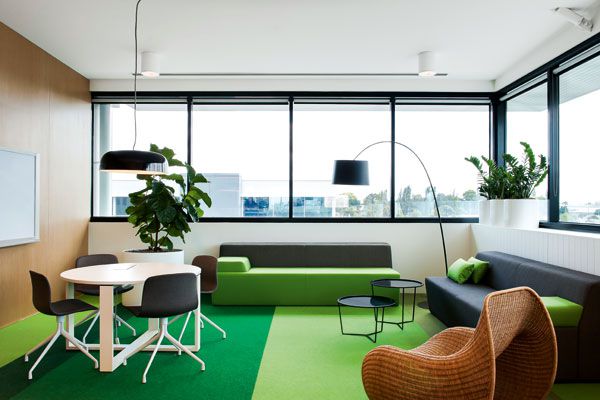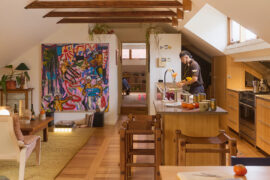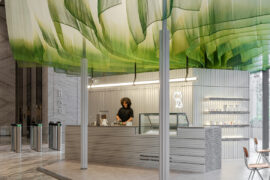Arnold Lane director, Chris Lane, discusses how Gibbon Group’s carpets contributed to the Interactive workplace, featured in Indesign Magazine #62 (on sale August 20).

July 21st, 2015
Above: Interactive, Melbourne, by Arnold Lane Architects
Office design is becoming a very important reflection of a company’s brand—so how important was the use colour throughout the fit-out?
The quality of the built environment, facilities and client experience was the key brand consideration, the use of colour was not an important part of the original client brief. Colour was slowly introduced during the design process as a ‘subtle’ branding strategy for specific client areas, largely the auditorium, and to signify the collaborative or break out zones.
The client’s corporate colour is blue, and blue is not directly identifiable with any one client due to its broad use for corporate branding. We therefore largely steered clear of the use of the corporate colour.
Where we did reference the corporate colour we customised treftord carpet in blue hues in the auditorium.
Commercial spaces are certainly becoming more domesticized—how does flooring fit into this trend?
In our opinion the trend towards creating office spaces that are generally more warm or comfortable seems to respond to the desire to make office spaces feel more human. We approach this trend with restraint, as Carpets at Work ultimately the spaces must function as a commercial office. Colour, texture, balance and the tactile nature of natural products are good ways to introduce a warm, relaxed and comfortable feel to an office space. Rugs and customized flooring are an important tool to employ to translate the residential concept to an office space and identify zones.
Do the acoustics play a large part in choosing soft flooring for you—since a lot of offices are so open plan?
Acoustics are an important consideration on every project and one of the key elements to be resolved in achieving a quality, habitable space to either work or live. On this project, as with many commercial projects, the opportunity to introduce soft, noise absorbing materials is limited to largely soft flooring or specific acoustic products. The selection of the carpet and the opportunities we created to introduce carpet were important considerations throughout the design process.
How important was the look and texture of the flooring to you?
Once it was agreed to introduce colour via the flooring we turned to Tretford products for the available colour palette, customizing options and natural fibre texture. In our experience there is no other flooring product available that offers vibrant colours while retaining a natural appearance.
Catch the Gibon Group at Sydney Indesign, August 13-15 2015.
Gibon Group
gibbongroup.com.au
INDESIGN is on instagram
Follow @indesignlive
A searchable and comprehensive guide for specifying leading products and their suppliers
Keep up to date with the latest and greatest from our industry BFF's!

Gaggenau’s understated appliance fuses a carefully calibrated aesthetic of deliberate subtraction with an intuitive dynamism of culinary fluidity, unveiling a delightfully unrestricted spectrum of high-performing creativity.

How do our universities cater to education’s ‘new consumers’? That is 21st century students – new age info-natives who study, socialise and ‘hang’ in the spaces in-between home and the lecture theatre. RMIT’s New Academic Street is a radical re-make of a rapidly ageing campus, addressing changing student needs with a complex design scheme that puts the emphasis on technology and study.
HASSELL and Condensed’s recent installation in a Melbourne showroom was one of considerable scale and visual impact
The internet never sleeps! Here's the stuff you might have missed

Adelaide will debut its first city-wide design festival – every*where: Adelaide Design Week – from 20th to 24th August 2025.

Spacemen Studio foregrounds fabric and colour in a hospitality project inspired by the ritual preparation of matcha.